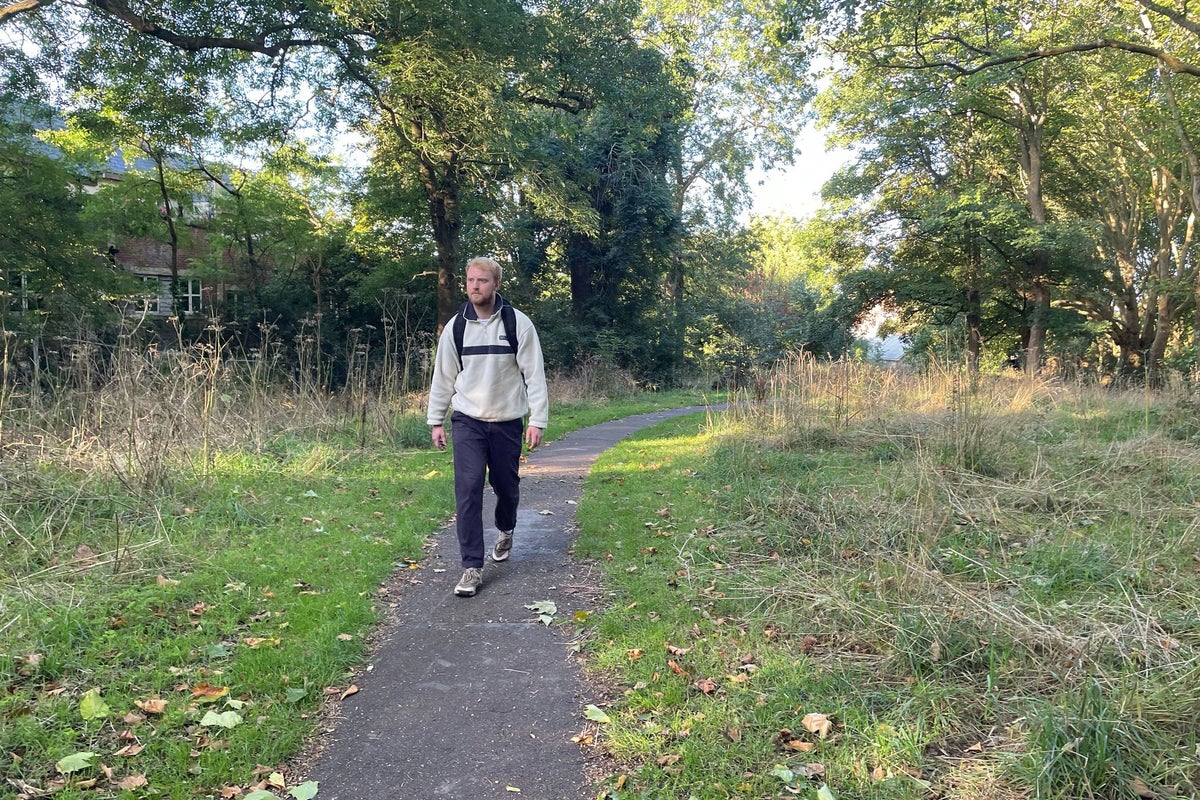Walking is an accessible form of movement with impressive health-boosting credentials; I think there is enough research available to safely make that statement. Treating 10,000 steps per day as the gold standard for a healthy lifestyle is far more contentious.
The number stems from a 1960s Japanese marketing campaign for a pedometer called the Manpo-Kei, or “10,000 steps metre”. It’s a nice round number, but it’s not one identified by science as the holy grail for health – a 2023 study by the University of Granada suggests that, while more is better, 8,000 is sufficient “to significantly reduce the risk of premature death”.
Walking 10,000 steps also takes a fair old while. Even at a decent nick, this task is likely to take you upwards of 90 minutes each day, making it a struggle for busy folks.
Recently, an alternative walking protocol – colloquially termed “Japanese walking” due to its country of origin – has stepped into the spotlight online. It takes just 30 minutes per day, with fitness coach and content creator Eugene Teo claiming it offers “10 times the benefits” of walking 10,000 steps per day in his viral video above.
As a fitness writer, I’ve covered walking extensively, finding it’s one of the best ways to help people of all fitness levels introduce more movement into their regular routine. So, intrigued, I endeavoured to try “Japanese walking” and find out if the impressive health claims around it held water.
How to try the ‘Japanese walking’ method
Complete the sequence below five times without any breaks:
- Three minutes of walking at a low intensity (40 per cent peak aerobic capacity, or a relaxed pace)
- Three minutes of walking at a high intensity (70 per cent peak aerobic capacity, or a brisk pace)
Benefits of Japanese walking
The “Japanese walking” protocol comes from a study published in the Mayo Clinic Proceedings journal in 2007. It was designed to test whether high-intensity interval walking training (IWT) can offer greater benefits than moderate-intensity continuous walking training, in terms of improving thigh muscle strength, peak aerobic capacity (the maximum amount of oxygen you can take in and use during exercise) and blood pressure.
Over five months, 60 men and 186 women with an average age of 63 were divided into three groups; no walking training, IWT and CWT (continuous walking training). The CWT group was instructed to walk at 50 per cent of their peak aerobic capacity (a fairly slow pace) and take 8,000 or more steps per day at least four times per week. The IWT group was told to complete the protocol above, four or more times per week.
Among participants who met these conditions, those in the IWT group saw a 13 per cent increase in isometric knee flexion, a 17 per cent increase in isometric knee flexion, and an eight per cent increase in peak aerobic capacity for walking. This was “significantly greater than the increases observed in the moderate-intensity continuous walking training group”.
The research also found a greater reduction in resting systolic blood pressure in the IWT group, despite the fact they didn’t spend as much time walking each week.
The conclusion states: “high-intensity interval walking may protect against age-associated increases in blood pressure and decreases in thigh muscle strength and peak aerobic capacity.”
Read more: The latest walking trend that could help burn more calories and lower blood pressure

What happened when I tried Japanese walking
I don’t have a full science lab set up at home; what I do have is two legs, a Garmin watch and a lot of walking experience, so I decided to put these to good use.
During my Monday lunch break, I took my dog for a 30-minute walk as normal. Then, at 1pm the following day, I tried the “Japanese walking” method on the same looped route, setting my Garmin Vivoactive to record both sessions and taking note of any subjective changes I felt.
My usual 30-minute walk saw me accrue nearly 3,000 steps, covering 2.12km at an average speed of 14min 10sec per kilometre. My heart rate averaged 85bpm, remaining fairly constant throughout, and I burned an estimated 157 calories.
As anyone who has owned a dog might expect, there was a good deal of stopping and starting to inspect particularly interesting trees and bollards, and I defaulted to a fairly casual pace amid a busy work day.
For the Japanese walking protocol, my numbers looked a bit different, with my fast pace falling just below 120 steps per minute and my slow pace a few shy of 100 steps per minute.
I travelled significantly further, covering 2.94km and 3,500 steps at an average speed of 10min 12sec per kilometre. My average heart rate came out very similar (86bpm) but there were noticeable peaks (104bpm) and troughs in line with the high- and low-speed intervals. My estimated calorie burn was also significantly higher: 211.
Read more: How many steps to take each day to slash your risk of cancer
Benefits of the Japanese walking method
The idea that walking faster, or sprinkling more intensity into your exercise, holds greater benefits is nothing new.
Specialist in walking for health, Dr Elroy Aguiar, is an assistant professor at the University of Alabama’s department of kinesiology. He was the lead author on a 2024 paper published in the Scandinavian Journal of Medicine and Science in Sports, which correlated as little as one minute of high-intensity activity with improved health outcomes.
“One of the really interesting findings from our paper was that, if you look at people’s highest one minute of activity across each day, averaged across the monitoring period, that was a very strong signal for whether they had one or more metabolic syndrome risk factors [elevated waist circumference, high triglycerides, low HDL (or “good” cholesterol), high blood pressure and high blood sugar] present,” he tells me.
Another series of studies he worked on, featured in the British Journal of Sports Medicine, pointed to the fact that “if you walk at a cadence of about 100 steps per minute, that’s equivalent to what’s called ‘moderate-intensity’, and all of the research in this area suggests that most of the benefits [of walking] accumulate at a moderate or higher intensity”.
Beyond this, completing the Japanese walking method four times per week leaves you half-an-hour away from the World Health Organisation’s “global recommendations of at least 150 minutes of moderate-intensity physical activity per week”. Add a couple of short full-body strength training sessions into the mix and you have a decent minimalist workout plan for beginners.
Read more: How your step count became the ultimate modern humblebrag

Potential drawbacks of the Japanese Walking method
All of the information above paints the Japanese walking method in a favourable light – as it should, with the protocol delivering impressive results in a non-intimidating time-span. However, if we are questioning the claim that it is “better” than walking 10,000 steps a day, there are a few further areas to consider.
Firstly, Dr Aguiar’s 2024 paper supported the idea that the “best” walking method for reducing metabolic risk factors involves a combination of high volume (number of steps) and high intensity (walking speed).
“Accumulating a high volume of walking throughout the day [8,000-plus steps], then focussing on at least 30 minutes of faster walking or jogging, would be a way to move the metrics in a positive direction and lower your metrics for each of the [metabolic syndrome] risk factors,” he says.
I racked up a little over 3,500 steps when trying the Japanese Walking method – less than half of the 8,000 daily steps research has repeatedly linked to many favourable health outcomes, and short of the 5,000 mark often viewed as the threshold for a sedentary lifestyle.
Using this method as part, rather than all, of your daily steps could be a better approach for achieving your health goals. However, if you only have 30 minutes per day free, it still offers dramatically more benefits than not moving at all, and improved return on investment over a regular 30-minute walk.
Another area where the Japanese walking method loses out to walking 10,000 steps per day is movement regularity. While the former involves a concentrated 30-minute dose of activity, the latter can be spread throughout the day, encouraging you to abandon your office chair and sofa more often.
A 10-year study of 8,000 people, published in the American Journal of Epidemiology, found that those replaced 30 minutes of daily sitting with light activity had a 17 per cent lower risk of dying in that period. This even applied if they accrued these 30 minutes across short intervals throughout the day – hence why your smartwatch is constantly sending you reminders to stand up and move.
Regular movement can also help maintain mobility and reduce stiffness in our joints and muscles.
“When we’re dealing with an adaptation from stillness, movement is the answer, so any movement is better than just being still,” movement mechanics expert and The Training Stimulus founder Ash Grossmann summarises.
The final factor to consider is enjoyment. By adding a rigid framework, Japanese walking ensures intensity. However, it also meant I was unable to stop and chat to people in the park or appreciate my surroundings to the same extent. For me, this lowered the stress-busting potential of my walk, sacrificing some of the usual mental health benefits of walking for physical ones.
Read more: What the heck is a fart walk? Why this practice is being hailed as the secret to healthy aging

The Japanese walking method: the verdict
In my time writing about health and fitness, the net positive effect of regular movement has been one of the most striking common denominators.
For those looking for a minimum effective dose: any movement will do you a lot of good, particularly if your starting point is a sedentary lifestyle. But if you can fit one or two quick full-body strength training sessions, regular aerobic activity (like walking) and an occasional dash of more intense exercise into each week, it will stand you in very good stead.
Walking is among the most accessible forms of exercise there is, lowering the barrier to entry for exercise for billions of people, which is why I’m always keen to promote it. However, in the modern world, even finding time for a quick walk can be tricky for particularly busy individuals.
The Japanese walking method provides a time-savvy way to enjoy many of the benefits of a greater volume of daily walking. Sure, you could enjoy higher-intensity exercise in any number of other forms, from cycling to a HIIT workout, but walking remains the most efficient – you don’t even need a change of clothes.
So should you try it? Yes, especially if you’re short on time and looking for a way to squeeze health-boosting movement into your day. And should you stick with it? This depends.
If you enjoy this framework, or find it’s something you can stick to with a good degree of regularity, that’s the ticket to a sustainable movement habit and the many health benefits that come from it. If not, look for an alternative form of moderate- to high-intensity exercise that you find fun, and commit to this instead – consistency is the key to long-term results.
Read more: Walking 10,000 steps day might not matter if you don’t do this one thing, according to an expert




.jpeg?trim=0,0,0,0&width=1200&height=800&crop=1200:800)